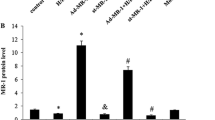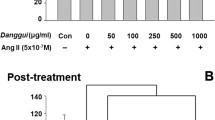Abstract
Canstatin, a non-collagenous fragment, is cleaved from type IV collagen α2 chain, an essential component of basement membrane surrounding cardiomyocytes. Although canstatin is known as an endogenous anti-angiogenic factor, its effects on cardiomyocytes have not been clarified. This study examined the effects of canstatin on isoproterenol-induced apoptosis in differentiated H9c2 cardiomyoblasts. Retinoic acid was used to differentiate H9c2 myoblast to cardiomyocyte-like phenotype. Cell viability was determined by a cell counting assay. Western blotting was performed to detect expression of cleaved casepase-3 and phosphorylation of dynamin related protein (Drp)1 at Ser637 which regulates mitochondrial fission. Mito Sox Red staining was performed to examine a mitochondria-dependent production of reactive oxygen species (ROS). Mitochondrial morphology was detected by Mito Tracker Red staining. Isoproterenol (100 μM, 48 h) significantly decreased cell viability and increased cleaved caspase-3 expression, which were inhibited by canstatin (10–250 ng/ml) in a concentration-dependent manner. Canstatin suppressed the isoproterenol-induced mitochondrial fission but not ROS. Canstatin also inhibited the isoproterenol-induced dephosphorylation of Drp1 at Ser637. In conclusion, canstatin inhibits isoproterenol-induced apoptosis through the inhibition of mitochondrial fission via the suppression of dephosphorylation of Drp1 at Ser637 in differentiated H9c2 cardiomyoblasts.





Similar content being viewed by others
Abbreviations
- DMEM:
-
Dulbecco’s modified Eagle’s Medium
- Drp1:
-
Dynamin related protein 1
- NFAT:
-
Nuclear factor of activated T-cells
- PI3K:
-
Phosphatidylinositol 3-kinase
- ROS:
-
Reactive oxygen species
- S.E.M.:
-
Standard error of the mean
References
Hasking GJ, Esler MD, Jennings GL, Burton D, Johns JA, Korner PI (1986) Norepinephrine spillover to plasma in patients with congestive heart failure: evidence of increased overall and cardiorenal sympathetic nervous activity. Circulation 73:615–621
Lymperopoulos A, Rengo G, Koch WJ (2013) Adrenergic nervous system in heart failure: pathophysiology and therapy. Circ Res 113:739–753
Parati G, Esler M (2012) The human sympathetic nervous system: its relevance in hypertension and heart failure. Eur Heart J 33:1058–1066
Wang Y, Seto SW, Golledge J (2014) Angiotensin II, sympathetic nerve activity and chronic heart failure. Heart Fail Rev 19:187–198
Amin P, Singh M, Singh K (2011) Beta-adrenergic receptor-stimulated cardiac myocyte apoptosis: role of beta1 integrins. J Signal Transduct 2011:179057
Choudhary R, Mishra KP, Subramanyam C (2006) Interrelations between oxidative stress and calcineurin in the attenuation of cardiac apoptosis by eugenol. Mol Cell Biochem 283:115–122
Communal C, Singh K, Pimentel DR, Colucci WS (1998) Norepinephrine stimulates apoptosis in adult rat ventricular myocytes by activation of the beta-adrenergic pathway. Circulation 98:1329–1334
Menon B, Singh M, Ross RS, Johnson JN, Singh K (2006) beta-Adrenergic receptor-stimulated apoptosis in adult cardiac myocytes involves MMP-2-mediated disruption of beta1 integrin signaling and mitochondrial pathway. Am J Physiol Cell Physiol 290:C254–C261
Remondino A, Kwon SH, Communal C et al (2003) Beta-adrenergic receptor-stimulated apoptosis in cardiac myocytes is mediated by reactive oxygen species/c-Jun NH2-terminal kinase-dependent activation of the mitochondrial pathway. Circ Res 92:136–138
Singh K, Xiao L, Remondino A, Sawyer DB, Colucci WS (2001) Adrenergic regulation of cardiac myocyte apoptosis. J Cell Physiol 189:257–265
Hudson BG, Reeders ST, Tryggvason K (1993) Type IV collagen: structure, gene organization, and role in human diseases. Molecular basis of Goodpasture and Alport syndromes and diffuse leiomyomatosis. J Biol Chem 268:26033–26036
Kuhn K (1995) Basement membrane (type IV) collagen. Matrix Biol 14:439–445
Pasco S, Brassart B, Ramont L, Maquart FX, Monboisse JC (2005) Control of melanoma cell invasion by type IV collagen. Cancer Detect Prev 29:260–266
Shamhart PE, Meszaros JG (2010) Non-fibrillar collagens: key mediators of post-infarction cardiac remodeling? J Mol Cell Cardiol 48:530–537
Watanabe T, Kusachi S, Yamanishi A et al (1998) Localization of type IV collagen alpha chain in the myocardium of dilated and hypertrophic cardiomyopathy. Jpn Heart J 39:753–762
Yamanishi A, Kusachi S, Nakahama M et al (1998) Sequential changes in the localization of the type IV collagen alpha chain in the infarct zone: immunohistochemical study of experimental myocardial infarction in the rat. Pathol Res Pract 194:413–422
He GA, Luo JX, Zhang TY, Wang FY, Li RF (2003) Canstatin-N fragment inhibits in vitro endothelial cell proliferation and suppresses in vivo tumor growth. Biochem Biophys Res Commun 312:801–805
He GA, Luo JX, Zhang TY, Hu ZS, Wang FY (2004) The C-terminal domain of canstatin suppresses in vivo tumor growth associated with proliferation of endothelial cells. Biochem Biophys Res Commun 318:354–360
Kamphaus GD, Colorado PC, Panka DJ et al (2000) Canstatin, a novel matrix-derived inhibitor of angiogenesis and tumor growth. J Biol Chem 275:1209–1215
Magnon C, Galaup A, Mullan B et al (2005) Canstatin acts on endothelial and tumor cells via mitochondrial damage initiated through interaction with alphavbeta3 and alphavbeta5 integrins. Cancer Res 65:4353–4361
Mundel TM, Kalluri R (2007) Type IV collagen-derived angiogenesis inhibitors. Microvasc Res 74:85–89
Panka DJ, Mier JW (2003) Canstatin inhibits Akt activation and induces Fas-dependent apoptosis in endothelial cells. J Biol Chem 278:37632–37636
Shewchuk LJ, Bryan S, Ulanova M, Khaper N (2010) Integrin beta3 prevents apoptosis of HL-1 cardiomyocytes under conditions of oxidative stress. Can J Physiol Pharmacol 88:324–330
Comelli M, Domenis R, Bisetto E et al (2011) Cardiac differentiation promotes mitochondria development and ameliorates oxidative capacity in H9c2 cardiomyoblasts. Mitochondrion 11:315–326
Menard C, Pupier S, Mornet D, Kitzmann M, Nargeot J, Lory P (1999) Modulation of L-type calcium channel expression during retinoic acid-induced differentiation of H9C2 cardiac cells. J Biol Chem 274:29063–29070
Branco AF, Sampaio SF, Wieckowski MR, Sardao VA, Oliveira PJ (2013) Mitochondrial disruption occurs downstream from beta-adrenergic overactivation by isoproterenol in differentiated, but not undifferentiated H9c2 cardiomyoblasts: differential activation of stress and survival pathways. Int J Biochem Cell Biol 45:2379–2391
Okada M, Oba Y, Yamawaki H (2015) Endostatin stimulates proliferation and migration of adult rat cardiac fibroblasts through PI3K/Akt pathway. Eur J Pharmacol 750:20–26
Kazama K, Okada M, Yamawaki H (2015) Adipocytokine, omentin inhibits doxorubicin-induced H9c2 cardiomyoblasts apoptosis through the inhibition of mitochondrial reactive oxygen species. Biochem Biophys Res Commun 457:602–607
Morita T, Okada M, Hara Y, Yamawaki H (2013) Addition of adult serum improves endothelium-dependent relaxation of organ-cultured rat mesenteric artery via inhibiting mitochondrial reactive oxygen species. Vascul Pharmacol 58:105–111
Cereghetti GM, Stangherlin A, Martins de Brito O et al (2008) Dephosphorylation by calcineurin regulates translocation of Drp1 to mitochondria. Proc Natl Acad Sci USA 105:15803–15808
Somvanshi RK, Zou S, Qiu X, Kumar U (2014) Somatostatin receptor-2 negatively regulates beta-adrenergic receptor mediated Ca(2 +) dependent signaling pathways in H9c2 cells. Biochim Biophys Acta 1843:735–745
Sata M, Walsh K (1998) TNFalpha regulation of Fas ligand expression on the vascular endothelium modulates leukocyte extravasation. Nat Med 4:415–420
Sata M, Suhara T, Walsh K (2000) Vascular endothelial cells and smooth muscle cells differ in expression of Fas and Fas ligand and in sensitivity to Fas ligand-induced cell death: implications for vascular disease and therapy. Arterioscler Thromb Vasc Biol 20:309–316
Feng QZ, Zhao YS, Abdelwahid E (2008) The role of Fas in the progression of ischemic heart failure: prohypertrophy or proapoptosis. Coron Artery Dis 19:527–534
Lu F, Xing J, Zhang X et al (2013) Exogenous hydrogen sulfide prevents cardiomyocyte apoptosis from cardiac hypertrophy induced by isoproterenol. Mol Cell Biochem 381:41–50
Adams JW, Pagel AL, Means CK, Oksenberg D, Armstrong RC, Brown JH (2000) Cardiomyocyte apoptosis induced by Galphaq signaling is mediated by permeability transition pore formation and activation of the mitochondrial death pathway. Circ Res 87:1180–1187
Xu G, Ahn J, Chang S et al (2012) Lipocalin-2 induces cardiomyocyte apoptosis by increasing intracellular iron accumulation. J Biol Chem 287:4808–4817
Cosentino K, Garcia-Saez AJ (2014) Mitochondrial alterations in apoptosis. Chem Phys Lipids 181:62–75
Dorn GW 2nd (2015) Mitochondrial dynamism and heart disease: changing shape and shaping change. EMBO Mol Med 7:865–877
Seo AY, Joseph AM, Dutta D, Hwang JC, Aris JP, Leeuwenburgh C (2010) New insights into the role of mitochondria in aging: mitochondrial dynamics and more. J Cell Sci 123:2533–2542
Hall AR, Burke N, Dongworth RK, Hausenloy DJ (2014) Mitochondrial fusion and fission proteins: novel therapeutic targets for combating cardiovascular disease. Br J Pharmacol 171:1890–1906
Otera H, Mihara K (2012) Mitochondrial dynamics: functional link with apoptosis. Int J Cell Biol 2012:821676
Zaja I, Bai X, Liu Y et al (2014) Cdk1, PKCdelta and calcineurin-mediated Drp1 pathway contributes to mitochondrial fission-induced cardiomyocyte death. Biochem Biophys Res Commun 453:710–721
Yu T, Sheu SS, Robotham JL, Yoon Y (2008) Mitochondrial fission mediates high glucose-induced cell death through elevated production of reactive oxygen species. Cardiovasc Res 79:341–351
Sheridan C, Martin SJ (2010) Mitochondrial fission/fusion dynamics and apoptosis. Mitochondrion 10:640–648
Molkentin JD, Lu JR, Antos CL et al (1998) A calcineurin-dependent transcriptional pathway for cardiac hypertrophy. Cell 93:215–228
Saito S, Hiroi Y, Zou Y et al (2000) beta-Adrenergic pathway induces apoptosis through calcineurin activation in cardiac myocytes. J Biol Chem 275:34528–34533
Belkin AM, Stepp MA (2000) Integrins as receptors for laminins. Microsc Res Tech 51:280–301
Wang YG, Ji X, Pabbidi M, Samarel AM, Lipsius SL (2009) Laminin acts via focal adhesion kinase/phosphatidylinositol-3′ kinase/protein kinase B to down-regulate beta1-adrenergic receptor signalling in cat atrial myocytes. J Physiol 587:541–550
Ortega N, Werb Z (2002) New functional roles for non-collagenous domains of basement membrane collagens. J Cell Sci 115:4201–4214
Yasuda J, Takada L, Kajiwara Y, Okada M, Yamawaki H (2015) Endostatin inhibits bradykinin-induced cardiac contraction. J Vet Med Sci 77:1391–1395
Baskin KK, Rodriguez MR, Kansara S et al (2014) MAFbx/Atrogin-1 is required for atrophic remodeling of the unloaded heart. J Mol Cell Cardiol 72:168–176
Yamamoto Y, Hoshino Y, Ito T et al (2008) Atrogin-1 ubiquitin ligase is upregulated by doxorubicin via p38-MAP kinase in cardiac myocytes. Cardiovasc Res 79:89–96
Ni YG, Berenji K, Wang N et al (2006) Foxo transcription factors blunt cardiac hypertrophy by inhibiting calcineurin signaling. Circulation 114:1159–1168
Acknowledgments
This research was supported by Kitasato University Research Grant for Young Researchers and JSPS KAKENHI Grant Number 24780289 (Grant-in-Aid for Young Scientists B).
Author information
Authors and Affiliations
Corresponding author
Rights and permissions
About this article
Cite this article
Okada, M., Morioka, S., Kanazawa, H. et al. Canstatin inhibits isoproterenol-induced apoptosis through preserving mitochondrial morphology in differentiated H9c2 cardiomyoblasts. Apoptosis 21, 887–895 (2016). https://doi.org/10.1007/s10495-016-1262-1
Published:
Issue Date:
DOI: https://doi.org/10.1007/s10495-016-1262-1




